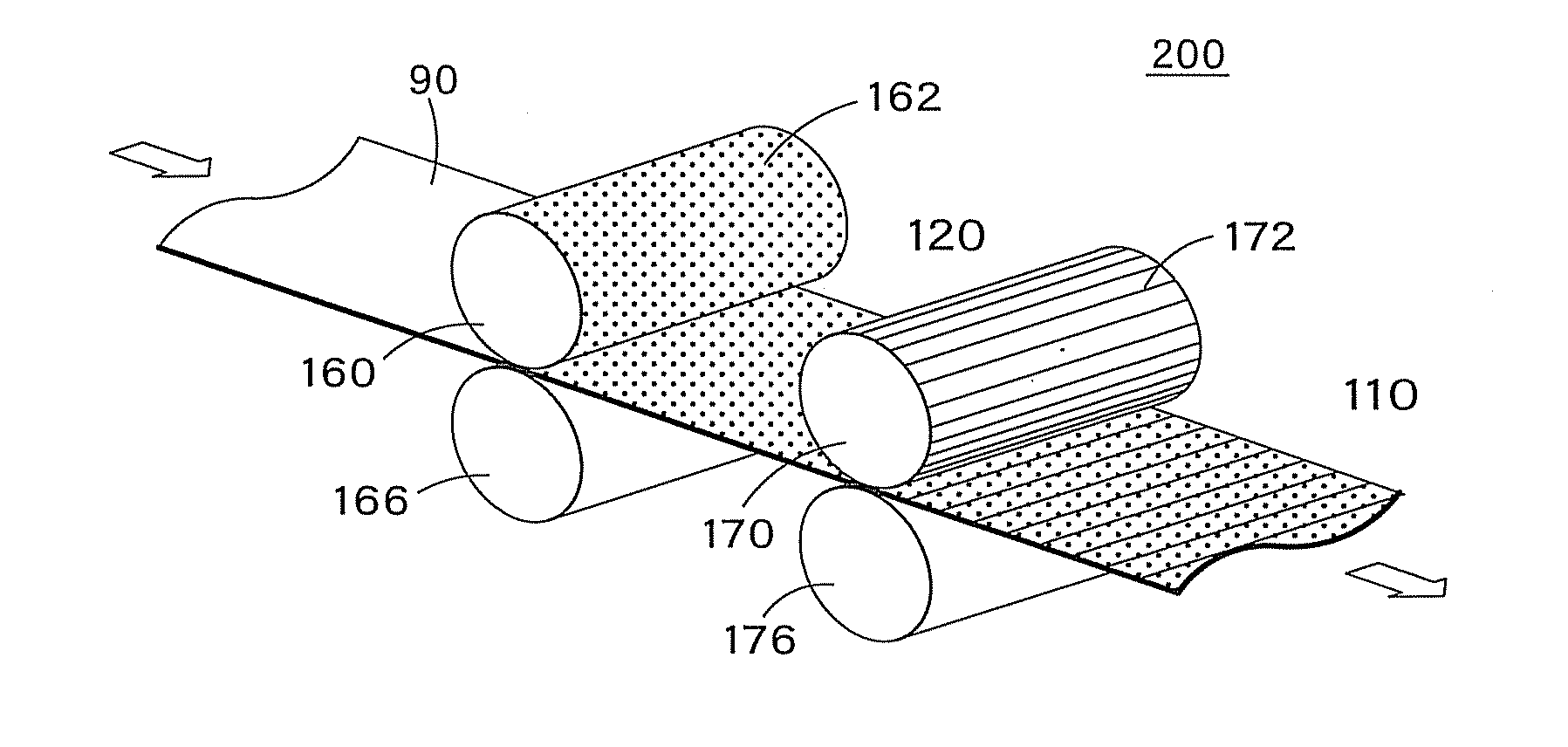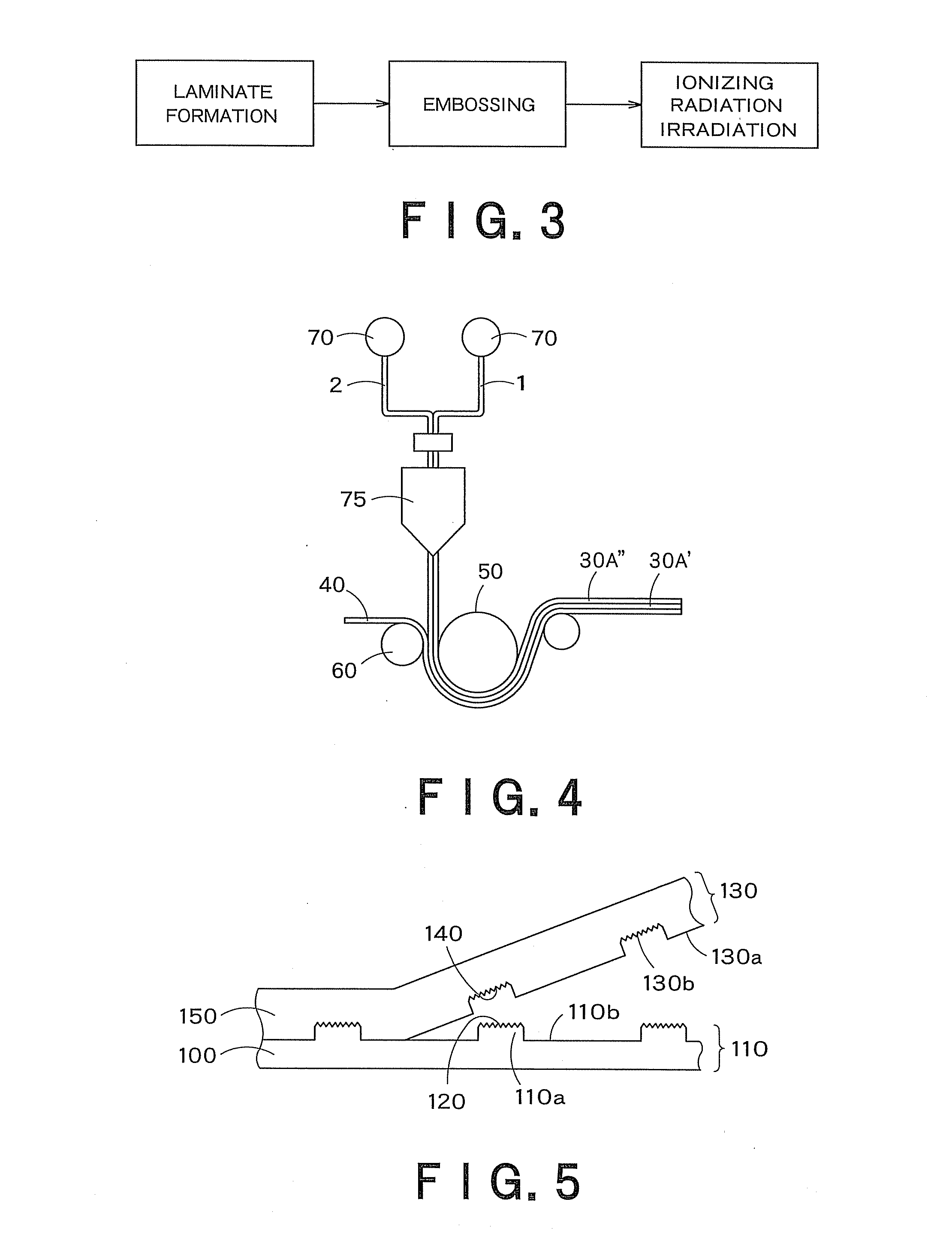Embossed release paper and process for producing the same
a technology of embossing paper and embossing surface, which is applied in the direction of patterned paper, thermography, synthetic resin layered products, etc., can solve the problems of uneven gloss, uneven surface, uneven embossing, etc., and achieve high embossing properties, high solvent resistance, cost-effective
- Summary
- Abstract
- Description
- Claims
- Application Information
AI Technical Summary
Benefits of technology
Problems solved by technology
Method used
Image
Examples
synthesis example 1
[0148]30 g of methyl methacrylate and 70 g of glycidyl methacrylate as monomers and 90 g of methyl ethyl ketone as a solvent were placed in a glass flask equipped with a stirrer, a dropping funnel, a reflux condenser, a nitrogen gas introduction tube, and a thermometer, and the contents were heated to 80° C. A solution of 1.0 g of 2,2′-azobis(2,4-dimethylvaleronitrile) as a polymerization initiator dissolved in 12 g of methyl ethyl ketone was then added dropwise over a period of 3 hr, and, further, a polymerization reaction was allowed to proceed at 80° C. for 3 hr to give a methyl ethyl ketone solution of an epoxy group-containing copolymer A1 (solid content: 50.1%). Subsequently, the temperature was maintained at 80° C., and, in this state, while introducing dry air, 0.05 g of hydroquinone monomethyl ether, 1.0 g of triphenylphosphine, 25 g of acrylic acid, and 25 g of methyl ethyl ketone were added. In this state, a reaction was allowed to proceed for 35 hr to give a methyl ethyl...
synthesis examples 2 to 13
[0149]Polymerization and reactions were carried out in the same manner as in Synthesis Example 1, except that the starting materials were changed to those shown in Tables 1 and 2. Thus, methyl ethyl ketone solutions of (meth)acryloyl group-containing acrylic copolymers (solid content: 50.8%) were produced. The weight average molecular weight, number average molecular weight, glass transition temperature, and double bond equivalent of the copolymers are shown in Tables 1 and 2. Only for Synthesis Example 8, the amount of 2,2′-azobis(2,4-dimethylvaleronitrile) used was changed to 2.6 g to change the weight average molecular weight of the copolymer.
[0150]Abbreviations in the tables are as follows.
[0151]IBX: isobornyl methacrylate,
[0152]MMA: methyl methacrylate,
[0153]BMA: butyl methacrylate,
[0154]IBMA: isobutyl methacrylate,
[0155]GMA: glycidyl methacrylate,
[0156]AA: acrylic acid,
[0157]Mn: number average molecular weight, and
[0158]Mw: weight average molecular weight
TABLE 1SynthesisSynthe...
synthesis example 14
[0169]A heat-curable silicone ionizing radiation-curable composition was produced by mixing 100 parts by mass of a main agent formed of an addition polymerizable silicone material formed of a mixture of an alkenyl group-containing organopolysiloxane with an organohydrogenpolysiloxane (KS-3603, manufactured by Shin-Etsu Chemical Co., Ltd.), 5 parts by mass of a curing agent formed of a platinum-based curing catalyst (CAT-PL-50T, manufactured by Shin-Etsu Chemical Co., Ltd.), and toluene as a diluting solvent added to give a solid content of 10% by mass.
PUM
| Property | Measurement | Unit |
|---|---|---|
| Temperature | aaaaa | aaaaa |
| Percent by mass | aaaaa | aaaaa |
| Percent by mass | aaaaa | aaaaa |
Abstract
Description
Claims
Application Information
 Login to View More
Login to View More - R&D
- Intellectual Property
- Life Sciences
- Materials
- Tech Scout
- Unparalleled Data Quality
- Higher Quality Content
- 60% Fewer Hallucinations
Browse by: Latest US Patents, China's latest patents, Technical Efficacy Thesaurus, Application Domain, Technology Topic, Popular Technical Reports.
© 2025 PatSnap. All rights reserved.Legal|Privacy policy|Modern Slavery Act Transparency Statement|Sitemap|About US| Contact US: help@patsnap.com



